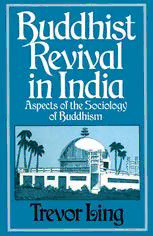
Buddhist Revival in India: Aspects of the sociology of Buddhism PDF
Preview Buddhist Revival in India: Aspects of the sociology of Buddhism
BUDDHIST REVIVAL IN INDIA By the same author The Buddha: Buddhist Civilisation in India and Ceylon Buddha, Marx and God (second edition) A History ofR eligion East and West Karl Marx and Religion Religious Change and the Secular State Buddhism and the Mythology of Evil Buddhism, Imperialism and War BUDDHIST REVIVAL IN INDIA Aspects of the sociology of Buddhism Trevor Ling Professor of Comparative Religion University of Manchester © Trevor Ling 1980 Softcover reprint of the hardcover 1st edition 1980 978-0-333-24533-0 All rights reserved. No part ofthis publication may be reproduced or transmitted, in any form or by any means, without permission First publlshed 1980 by THE MACMILLAN PRESS LTD London and Baslngstoke Assoclated companies In Delhi Dublln Hong Kong Johannesburg Lagos M elboume New rork Singapore Tokyo British Library Cataloguing in Publication Data Ling, Trevor Buddhist revival in India 1. Buddhism-India 2. Religion and sociology I. Title 301.5'8 BQ336 ISBN 978-1-349-16312-0 ISBN 978-1-349-16310-6 (eBook) DOI 10.1007/978-1-349-16310-6 This book Is sold subject to the standard conditions of the Net Book Agreement Contents Acknowledgements Vll PART ONE BUDDHISM AND BRAHMANISM 1 Alienated Hindus 3 The Buddhist way for India's Untouchables 3 The Hindu social order 5 The growth of dissent 8 2 Buddhist popularity in India 11 What became of Indian Buddhism? 11 Varieties of Buddhist culture 14 Max Weber's study of Buddhism 15 Buddhists and the political order 19 3 Buddhist decline in India 24 Explanations of Buddhist decline 24 Buddhism in Bengal 27 The evidence ofthe Chinese pilgrims and Taranatha 31 Buddhism and popular cults 37 The hostility of Brahmans 39 4 Buddhism in India today 47 The secular nature of the Republic of India 47 Buddhism in modern India: a survey 48 Buddhism in north-east India: Tibetan 50 Tibetan Buddhism: slow growth 54 Buddhism in north-east India: Burmese 57 The potential for Buddhist resurgence in India 58 v CONTENTS PART TWO ANTI-BRAHMANISM AND NEO-BUDDHISM 5 Anti-Brahmanism and Dr Ambedkar 6 7 The Hindu social order in the early twentieth century 6 7 Anti-Brahmanism 73 Ambedkar 's critique of Brahmanism 78 6 Ambedkar between Marxism and Buddhism 83 Ambedkar: a failed Marxist? 83 Ambedkar at the market of religions 85 Towards neo-Buddhism 88 7 Buddhism and wealth 93 Indian entrepr~neurs in Burma 93 Cultural values and economic values 95 Max Weber and Buddhist economic activity 96 Recent studies of Buddhist economic activity m Burma 100 8 Neo-Buddhism: an assessment 108 Consequences for Untouchables of conversiOn to Buddhism 108 The role of Ambedkar as culture-hero 116 Political disenchantment and diverging paths 120 The continuing depressed condition of the Scheduled Castes 123 The Buddhist future in India 127 Buddhist culture and Buddhist sect 129 Notes 135 Bibliographical References: Ambedkar and neo-Buddhism 145 Index 147 Vl Acknowledgements I am grateful for permission to reproduce' some passages which have appeared elsewhere. Much of Chapter 4 appeared originally as a contribution to the volume Pali and Buddhist Studies, edited by A. K. Narain (New Delhi, 1979). Chapter 3 includes, in a revised form, some material from my contributions to the volumes Man and His Salvation, edited by J. R. Hinnells and E. Sharpe (1973 ), and History and Society, edited by Debiprasad Chattopadhyaya (Calcutta, 1978). Some passages in Chapter 7 are from my inaug ural lecture at Leeds University, 'Max Weber in India', published in the Leeds University Review, May 1973. I should particularly like to mention the very generous help I have received from Mr Harish Chandra Gupta, Deputy Librarian of India's National Library, Calcutta, and to express my thanks to Mr Biswanath Chatterjee for his patient typing of my manuscript. Calcutta, January 7979 T.L. Vll Part One Buddhism and Brahmanism 1 Alienated Hindus The Buddhist way for India's Untouchables 'India has not yet taken back the faith of her Emperor Ashoka.' To Caroline Rhys Davids, writing these words from Manchester in 1910,1 it might have seemed that the revival of Buddhism in India could not long be delayed, even although it had not yet begun. Nineteenth century European scholars had worked ener getically and persistently at uncovering its historical origins. They had done so at a time when the Brahman view of ancient Indian history, 'in possession of the field when Europeans entered India, had been regarded so long with reverence,' commented T. W. Rhys Davids, that it seemed an impertinence to put for ward any other. 2 The orthodox Hindu of India would have thought it better to leave well alone, he continued. 'Why resusci tate from the well-deserved oblivion in which, for so many cen turies, they have happily lain, the pestilent views of these tiresome people [the Buddhists].'8 But considerable progress in European knowledge of Indian Buddhist origins and history had been made, and by the beginning of the twentieth century it was sufficient to embolden writers such as the Rhys Davids to present a different and more honourable view of Buddhism than had been taken pre viously, a view based on archaeological and textual evidence which seriously challenged 'the Brahman theories of caste and history'.4 In Buddhism India had produced a system of thought which, European scholars were beginning to recognise, was in certain ways more congenial and certainly more intelligible to modern minds than that of the orthodox Brahmans, who had for so long been regarded as the sole representatives of Indian philosophy. By the beginning of the twentieth century, therefore, it seemed that not only to Europeans but to modern Indians, too, Buddhism 3
